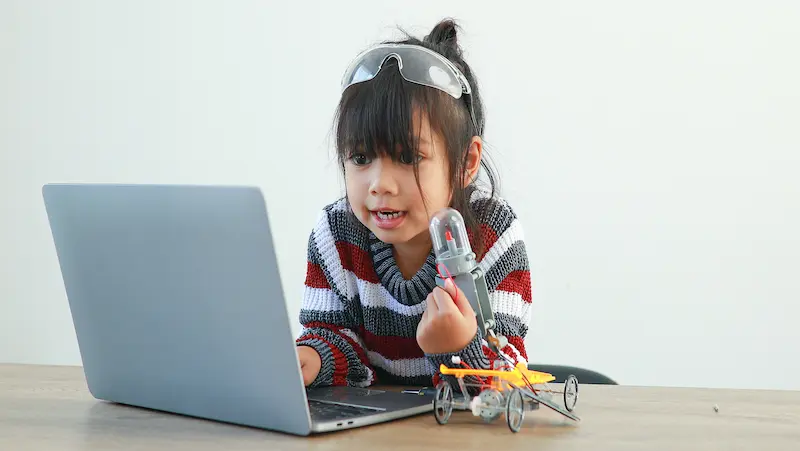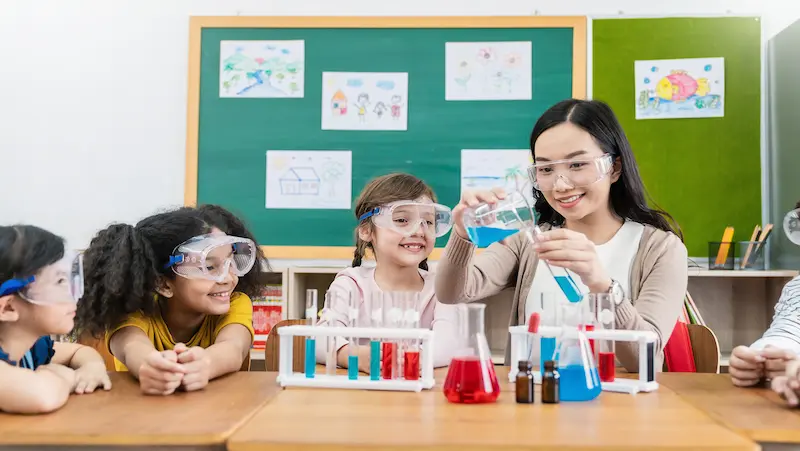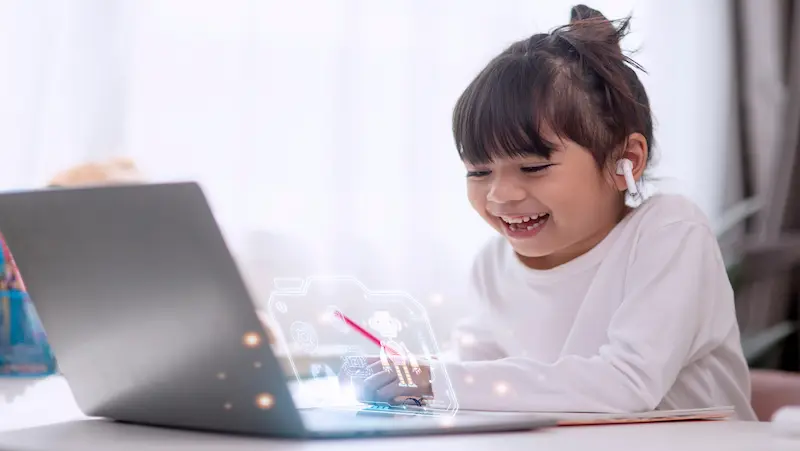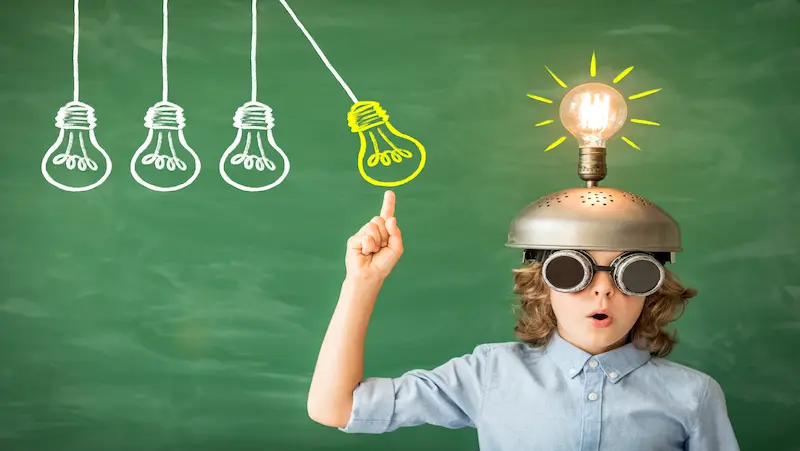Science education plays a vital role in the development of young minds, fostering curiosity, critical thinking, and problem-solving skills. In today’s rapidly advancing world, it is crucial to introduce children to the wonders of science from an early age. This blog aims to provide parents with a comprehensive guide to engaging their kids in science, offering a plethora of fun and educational activities that promote hands-on learning and exploration.
BrightChamps introduces various kids coding languages, unlocking the benefits of learning to code, such as improved problem-solving and logical thinking skills. Through our interactive courses, children can explore the world of coding, fostering creativity and equipping them with essential 21st-century skills for a successful future
Table of contents
Benefits of Science Education for Kids
Science education offers numerous benefits for children’s overall cognitive development. By engaging in scientific activities, children learn to observe, question, analyze, and draw conclusions. These skills not only enhance their critical thinking abilities but also foster a sense of wonder and curiosity about the world around them. Additionally, science education encourages creativity, logical reasoning, and problem-solving skills, which are essential for success in various fields.

Easy Science Experiments at Home
What better way to introduce science to kids than through exciting and easy experiments that can be conducted right at home? From creating homemade volcanoes to exploring the properties of magnets, there are countless experiments that parents can do with their children. These hands-on activities not only make science enjoyable but also provide valuable learning experiences. By engaging in these experiments, children gain a deeper understanding of scientific concepts and develop a love for exploration. Science experiments for kids offer a hands-on and exciting opportunity to explore the wonders of the natural world and foster a love for learning.

Here are three easy science experiments that you can do at home with your kids:
- Homemade Volcano
Materials needed:
- Baking soda
- Vinegar
- Dish soap
- Food coloring (optional)
- Small container (such as a plastic cup)
- Tray or newspaper (to catch spills)
Procedure:
- Place the small container on the tray or newspaper.
- Fill the container about halfway with vinegar.
- Add a few drops of food coloring and a squirt of dish soap to the vinegar.
- Create a small mound using baking soda next to the container.
- Slowly pour the vinegar mixture into the container over the baking soda and observe the reaction.
- Watch as the mixture fizzes and overflows like a volcano eruption.
Explanation: When vinegar (an acid) reacts with baking soda (a base), it produces carbon dioxide gas. The dish soap helps to create foam, and the food coloring adds visual interest. This experiment demonstrates a simple chemical reaction and showcases the properties of acids and bases.
- Dancing Raisins
Materials needed:
- Clear carbonated drink (e.g., lemon-lime soda)
- Raisins
Procedure:
- Pour some carbonated drink into a clear glass or container.
- Drop a few raisins into the drink and observe what happens.
- Observe the raisins as they move up and down in the liquid.
Explanation: The carbon dioxide gas present in the carbonated drink forms bubbles on the surface of the raisins. These bubbles attach to the raisins and cause them to float to the top. Once the bubbles pop at the surface, the raisins sink back down. This process repeats, creating the dancing effect.
- Static Electricity with Balloons
Materials needed:
- Balloons (inflated)
- Wool or synthetic fabric (e.g., polyester)
- Hair (optional)
Procedure:
- Rub the inflated balloon against the wool fabric or your hair for about 30 seconds.
- Slowly bring the balloon close to a wall or your hair and observe what happens.
- Try touching the balloon to different objects and see if they are attracted to it.
Explanation: When you rub the balloon against the fabric or hair, it becomes charged with static electricity. The balloon gains extra electrons and becomes negatively charged. The charged balloon then attracts or repels other objects with opposite or similar charges. This experiment demonstrates the concept of static electricity and how opposite charges attract each other.
Also, scratch coding for kids is an engaging and interactive way to introduce young learners to the world of programming.
Age-Appropriate Science Activities
Children’s science activities can be tailored to different age groups, ensuring that the content is both suitable and challenging. By aligning activities with their developmental stage, children can grasp scientific concepts more effectively. Here are some age-appropriate science activities for your kids: Also, Online games for kids provide a fun and educational platform where children can learn and develop important skills while having a great time.
Preschool (Ages 3-5):
- Sink or Float: Materials needed:
- Various objects (e.g., toy car, rubber duck, plastic spoon, cork)
- Large container filled with water
Procedure:
- Gather a selection of objects.
- Ask your child to predict whether each object will sink or float.
- Place the objects, one at a time, into the container of water and observe what happens.
- Discuss the results and compare them to the initial predictions.
- Color Mixing: Materials needed:
- Clear cups or containers
- Water
- Liquid food coloring (primary colors: red, blue, yellow)
Procedure:
- Fill the cups with water, leaving some space at the top.
- Add a different primary color of food coloring to each cup (e.g., red in one cup, blue in another, yellow in the third).
- Encourage your child to mix the colors by pouring one cup into another.
- Observe the resulting colors when the primary colors are combined (e.g., red + blue = purple).
Elementary School (Ages 6-9):
- Straw Rocket: Materials needed:
- Drinking straws
- Paper
- Tape
- Scissors
- Pencil
Procedure:
- Cut out a small triangular piece of paper.
- Roll the paper around a pencil to form a cone shape, leaving a small opening at the tip.
- Secure the cone shape with tape.
- Slide the straw through the opening at the back of the cone.
- Use tape to attach the cone to the straw.
- Place the rocket on a flat surface, blow through the straw, and watch it launch.
- Solar Oven: Materials needed:
- Cardboard box
- Aluminum foil
- Plastic wrap
- Black construction paper
- Scissors
- Tape
Procedure:
- Cut out a flap on the top of the cardboard box.
- Cover the inside of the flap and the inner sides of the box with aluminum foil.
- Cover the opening of the box with plastic wrap and secure it with tape.
- Line the bottom of the box with black construction paper.
- Place food items (e.g., marshmallows or chocolate) on the black construction paper inside the box.
- Set the solar oven in direct sunlight and observe how the heat trapped inside can melt the food.
Middle School (Ages 10-13):
- Lemon Battery: Materials needed:
- Lemon
- Copper coin (or penny)
- Zinc-coated nail
- Wires with alligator clips (or copper wire)
- LED light bulb
Procedure:
- Insert the zinc-coated nail and copper coin into the lemon, making sure they don’t touch each other.
- Connect one end of the wire to the copper coin and the other end to the longer leg of the LED light bulb.
- Connect one end of another wire to the zinc-coated nail and the other end to the shorter leg of the LED light bulb.
- Observe as the lemon battery powers the LED light bulb.
- Egg Geode: Materials needed:
- Raw egg
- White vinegar
- Food coloring (optional)
- Spoon
- Container or glass
Procedure:
- Carefully place a raw egg into a container or glass.
- Pour enough white vinegar over the egg to fully submerge it.
- Add a few drops of food coloring to the vinegar if desired.
- Let the egg sit in the vinegar for 24 to 48 hours.
- Remove the egg from the vinegar and rinse it gently with water.
- Observe the translucent and bouncy eggshell that remains.
These activities are designed to suit the developmental abilities and interests of children in each age group. Remember to provide guidance and supervision as needed, and encourage children to ask questions and explore further. Enjoy these science adventures with your kids!
Online Resources and Apps for Science Education

To supplement your child’s science education, there are numerous reliable online resources and educational apps available. Here are some recommended platforms that provide interactive and informative content for kids:
- Khan Academy: Khan Academy offers a wide range of educational videos and lessons on various subjects, including science. Their comprehensive science section covers topics from elementary to advanced levels, making it suitable for children of different ages.
- National Geographic Kids: National Geographic Kids provides a wealth of resources, including articles, videos, games, and quizzes, that cover diverse scientific topics. It offers a captivating and visually appealing learning experience for children.
- NASA Kids Club: NASA Kids Club is an interactive website where children can explore space-related topics through games, activities, and multimedia resources. It allows kids to learn about space missions, astronauts, and the wonders of the universe.
- Mystery Science: Mystery Science provides engaging video lessons and hands-on activities for children to explore scientific concepts. Their lessons are designed to spark curiosity and promote inquiry-based learning.
- PBS Kids: PBS Kids offers science-related games, videos, and activities that align with popular children’s shows like “Sid the Science Kid” and “The Cat in the Hat Knows a Lot About That!” It combines entertainment and education to make learning fun.
- Science Buddies: Science Buddies is a comprehensive website that provides project ideas, experiments, and resources for science fair projects. It offers step-by-step instructions and guidance for children to conduct scientific investigations.
- Toca Lab: Toca Lab is an educational app that allows children to explore the periodic table and learn about different elements through interactive experiments and activities. It encourages scientific exploration and discovery.
By incorporating these online resources and educational apps into your child’s learning routine, you can provide them with accessible and engaging ways to explore science topics and deepen their understanding of the subject.
BrightChamps offers a variety of coding apps for kids, providing a valuable educational experience through interactive and engaging platforms.
Conclusion
Science education for kids is of paramount importance in nurturing their curiosity, critical thinking, and problem-solving skills. By engaging in hands-on experiments, utilizing STEM learning resources, and integrating science into daily life, parents can provide a solid foundation for their child’s cognitive development. Learn about coding for kids too.
Staying updated with science education trends through newsletters, professional organizations, and online communities ensures that parents are equipped with the latest research and teaching methods. By embracing the wonders of science, parents can ignite a lifelong love for learning, open doors to future opportunities, and empower their children to become scientifically literate individuals capable of making meaningful contributions to society.
To get your hands on more such free educational resources, checkout Brightchamps Blog Page now!
Elevate your child’s learning journey with BrightChamps, the leading EdTech company offering a transformative blend of robotics, financial education, and coding courses.
Frequently Asked Questions (FAQ’s)
A1: There are plenty of easy science experiments you can try at home with your kids. For example, you can create a volcano using baking soda and vinegar, make a homemade lava lamp using oil, water, and food coloring, or explore density by making a homemade rainbow in a jar using different liquids. These experiments are not only fun and engaging but also promote hands-on learning and spark curiosity in your children.
A2: To encourage your child’s interest in science, you can provide them with opportunities for exploration and discovery. Foster their curiosity by encouraging questions and supporting their efforts to find answers. Engage in science-related activities, visit science museums, and expose them to age-appropriate science books and documentaries. Encourage their participation in science fairs or science clubs and provide them with resources, such as science kits or online educational platforms, to further their scientific learning.
A3: Yes, there are several recommended science kits and books for kids. Some popular science kits include those offered by brands like KiwiCo, Little Passports, and Steve Spangler Science. For books, consider titles such as “The Magic School Bus” series by Joanna Cole, “National Geographic Kids” books, and “Ada Twist, Scientist” by Andrea Beaty. These resources offer interactive and educational content that engages children in hands-on learning and exploration.
A4: Introducing STEM (Science, Technology, Engineering, and Mathematics) learning to children offers numerous benefits. It promotes critical thinking, problem-solving skills, creativity, and innovation. STEM education also encourages collaboration, communication, and teamwork. It prepares children for future careers in STEM fields, where there is a growing demand for skilled professionals. Additionally, STEM learning fosters an understanding of the world, and technology literacy, and empowers children to become informed and responsible global citizens.
A5: Certainly! Here are some age-appropriate science activities for different grade levels:
Kindergarten to 2nd Grade: Conduct simple experiments such as making slime, observing plant growth, or exploring the properties of water and ice.
3rd to 5th Grade: Engage in activities like building simple circuits, creating a homemade volcano, or conducting experiments on buoyancy and density.
6th to 8th Grade: Explore more complex experiments such as investigating chemical reactions, designing and building simple machines, or exploring the principles of magnetism and electricity.
A6: You can easily incorporate science into everyday activities with your child. For example, while cooking, you can involve them in measuring ingredients, observing chemical reactions, or discussing the science behind baking. During outdoor walks, encourage them to observe and identify plants, insects, or animals. Encourage questions and discussions about the natural world around them, and encourage them to hypothesize and find answers to their inquiries.
A7: Safety is paramount when conducting science experiments with kids. Always read and follow experiment instructions carefully. Use safety equipment like gloves or goggles when necessary. Choose age-appropriate experiments and supervise children closely. Avoid experiments involving hazardous materials or open flames without proper supervision. Teach children about safety precautions, such as not tasting or ingesting substances used in experiments. Additionally, maintain a clean and organized workspace to minimize potential risks.
A8: To find science-related events or workshops in your area for your child, you can:
Check with local museums, science centers, or planetariums for upcoming science events or workshops.
Contact schools or educational institutions in your area to inquire about science-related activities or clubs.
Look for community organizations or science-focused clubs that may offer science workshops for children.
Explore online event platforms or community bulletin boards specific to your locality, as they often feature science-related events or workshops.
A9: Yes, there are numerous online resources and educational apps available for science education. Some recommended platforms include Khan Academy, National Geographic Kids, Mystery Science, PBS Kids, and Science Buddies. These platforms offer interactive lessons, videos, activities, and experiments that cater to different age groups and cover various scientific topics.


 We are an army of educators and passionate learners from BrightChamps family, committed to providing free learning resources to kids, parents & students.
We are an army of educators and passionate learners from BrightChamps family, committed to providing free learning resources to kids, parents & students.













